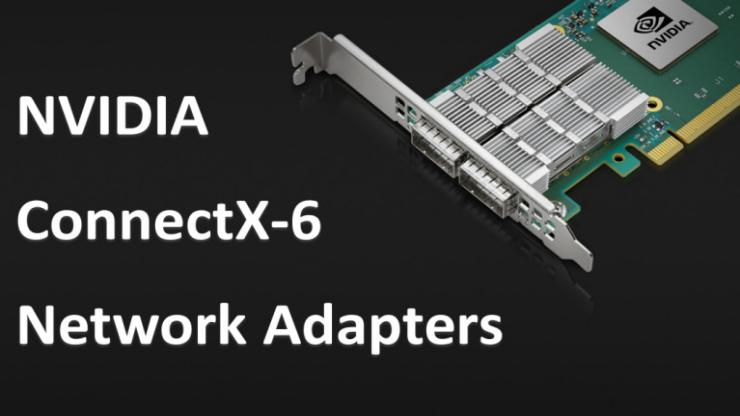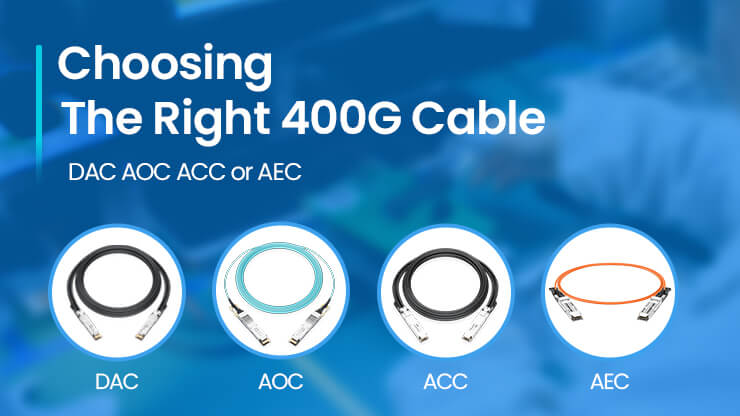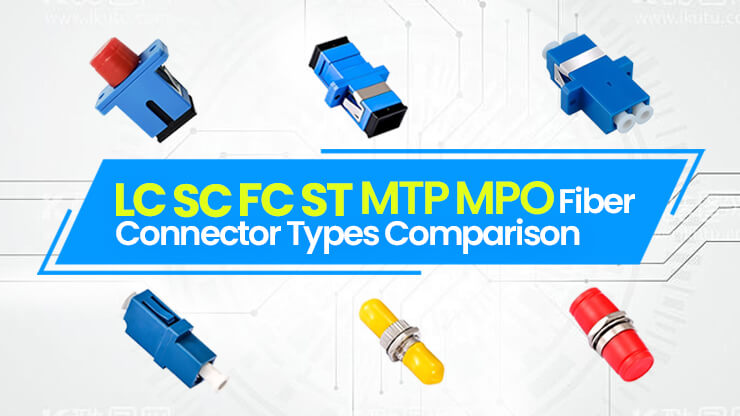Choosing the Right 400G Cable: DAC, AOC, ACC or AEC
The 400G high-speed cable is actually a combination of 400G modules and cables. Currently, the main types of 400G high-speed cables that are commonly available on the market are:
QSFP-DD is the most common packaging mode for 400G data centers, and it is a common packaging type for 400G DAC and 400G AOC. It adopts an 8*50GB/S PAM4 electrical modulation format.
OSFP is another packaging type used for 400G DAC and 400G AOC, using a 4*100Gb/s PAM4 electrical modulation format.
Cable Type
DAC
DAC stands for Direct Attach Cable, which refers to a copper cable used for direct connection. It can transmit electrical signals without the need for optical-electrical conversion and uses a single optical cable to connect two high-density connectors. It has the advantages of high performance, energy conservation, low power consumption, and low cost. Therefore, in short-distance application scenarios, it has the advantage of high performance, energy conservation, low power consumption, and low cost. Therefore, in short-distance application scenarios, it has become the preferred solution for users and is widely used in storage area networks, data centers, and high-performance computer connections.
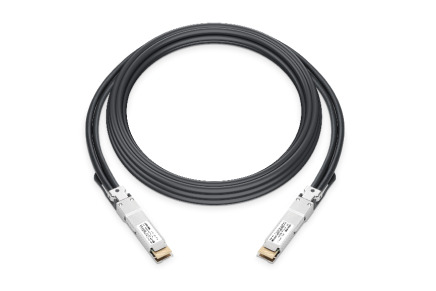
AOC
AOC (Active Optical Cable), refers to the communication able used in the communication process that requires external energy to convert electrical signals into optical signals or vice versa. The optical transceivers at both ends of the cable provide functions of photoelectric conversion and optical transmission. The basic structure of AOC high-speed cables consists of optical fibers, photoelectric converters, and connectors. AOC is relatively expensive, but it has superior transmission performance and is less susceptible to electromagnetic interference, making it suitable for long-distance and high-reliability applications, such as connections between core switches and long-distance transmission within data centers.
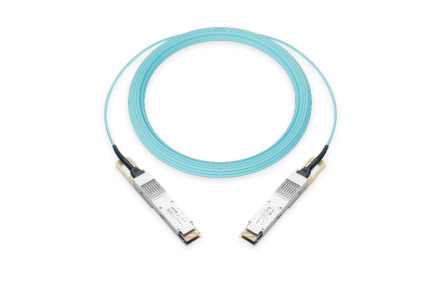
ACC
ACC(Active Copper Cable) is an active copper cable. It is similar in structure to DAC(Digital-to Analog Converter), but is can transmit signals over a longer distance than traditional copper cable DAC. It is essentially an active cable that amplifies the pseudo-signal. At the receiving end (RX end) of the cable, a certain level of linear Redriver is added to provide signal equalization and shaping. The chip is used to compensate for the high-frequency loss of the unconnected copper cable DAC. ACC can be used to connect TOR(Tie-Oriented Router) and Servers. It provides an economical and efficient way for short links, thereby offering greater bandwidth transmission.
AEC
AEC is an active cable that can amplify and equalize the transimitted signal, as well as reshape the signal, thereby extending the transmission distance. It is suitable for applications requiring long distances, low power consumption, and compact design. At a rate of 400G or 800G, the maximum transmission distance can reach up to 7 meters. Compared to DAC and ACC, it transmits further.
In-depth Comparison of 400G DAC, AOC, ACC and AEC Differences
Comparing in Terms of Transmission Distance
The transmission distance of 400G AOC is longer, with the maximum reaching 70meters(om3) or 100 meters(om4). The transmission distance of 400G AEC can reach 7meters. The transmission distance of 400G ACC can reach 5 meters. The transmission distance of 400G DAC is the shortest, with the maximum support being only 3meters.
Comparison of Price and Cost
The price of 400G AOC is higher than that of 400G DAC, 400G ACC and 400G AEC.
400G AOC is an optical fiber+module, including a laser, and its price is higher than that of 400G DAC, 400G ACC and 400G AEC.
400G DAC is a copper cable + module. The price of copper cable is much lower than that of optical fiber. Using DAC network cables can significantly reduce the wiring cost of the entire data center.
400G AEC is a copper cable+module. However, it does not include a laser, so its price is a little higher than DAC and a little lower than AOC.
400G ACC is an active copper cable, It adds the function of signal amplification on the basis of DAC, but does not have function of repair and recombination. Therefore, its price is relatively lower, but it is a little higher than DAC.
From the Perspective of Maintenance Costs Comparison
The DAC lacks the electro-optical conversion unit required by AOC, and its power consumption is much lower than that of AOC, generating less heat. The internal material of the cable for direct connection is copper core, and the natural heat dissipation effect of the copper wire is better, making it more energy-efficient and environmentally friendly.
The laser lifespan of AOC optical cables is generally 3-5 years, and the maintenance is rather difficult. Moreover, during operation, the loss generated by AOC and the heat loss are relatively high.
In Terms of the Convenience and Flexibility of Application Comparison
The volume and weight of AOC, ACC and AEC are smaller than those of DAC, making them more suitable for scenarios with limited space. Moreover, their optical cable diameters and bending radii are smaller, which makes them more flexible and convenient to use than DAC, and easier to organize.
Comparison of Stability and Anti-interference Capability
Since 400G AOC is composed of optical fibers, and optical fibers are insulating materials that do not conduct electricity, they are less susceptible to electromagnetic, lighting or radio signals during data transmission. The optical cable is also less affected by temperature. The 400G DAC cable used copper cables, and the copper cores are conductive, making it more prone to interference from lightning and other electrical sources.
What Fields are AOC, DAC, ACC and AEC More Suitable for? How Can One Select the Appropriate High-speed Cables?
In the 400G high-speed connection solution, AOC is the preferred solution for short-distance and high-performance transmission. It not only is easy to install but also has excellent anti-electromagnetic interference capability, ensuring the integrity of the signal and the stability of the system.
However, in data centers or HPC (High Performance Computing) centralized facilities where the density of equipment is high, the wiring is often within the same rack and does not require long-distance wiring. 400G DAC is an economical and efficient choice. 400G DAC is highly suitable for use within system racks, connecting computing servers and storage subsystems, and supports a transmission distance of up to 3 meters.
400G ACC is typically used in data centers and high-performance computing environments, connecting network devices, servers, storage arrays and other network components. Compared with 400G DAC, 400G ACC can offer longer transmission distances and lower transmission losses, and it is also more economically viable and has lower power consumption than 400G AOC.
400G AEC is more suitable for cabinet connections and distributed architecture applications. AEC has a longer transmission distance and a smaller size compared to DAC, which can save 70% of the wiring space. Moreover, it is cheaper than AOC.
Regarding 400G DAC, AOC, ACC, AEC Issues Answered
Q: Can I customize the length of the DAC, AOC, AEC and ACC cables?
A: Yes, we can customize the length of the cables according to the customer’s requirements.
Q: Can I replace 400G DAC with 400G AOC?
A: 400G AOC can replace 400G DAC, but AOC is the preferred choice for long-distance transmission.



